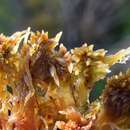Comments
(
Inglês
)
fornecido por eFloras
Sphagnum fuscum is common in ombrotrophic mires and alpine mountain summits where it may form small to large hummocks to 1 m in height, more infrequently in weakly minerotrophic mires and richer fens.
Sporophytes are common in Sphagnum fuscum, which is associated with S. angustifolium, S. fallax, S. magellanicum, S. papillosum, and more infrequently with S. teres, and S. warnstorfii in richer sites. Very widespread but generally easily recognized, it is the only small brown hummock-forming species of sect. Acutifolia over most of its range. There are some significant variations in this species. The stem leaves can vary from having a rounded, entire apex to having a somewhat flat and lacerate apex. The branches also vary from being unranked and slender to 5-ranked and blunt. The color also can vary from a light to a dark brown. There does not seem, however, to be any consistent pattern to these variations and thus no taxonomic recognition has been given to them. See also discussion under 73. S. flavicomans.
- licença
- cc-by-nc-sa-3.0
- direitos autorais
- Missouri Botanical Garden, 4344 Shaw Boulevard, St. Louis, MO, 63110 USA
- citação bibliográfica
- Flora of North America Vol. 27: 19, 86, 87, 89, 90, 92, 93, 94, 96, 97 in eFloras.org, Missouri Botanical Garden. Accessed Nov 12, 2008.
- fonte
- Flora of North America @ eFloras.org
- editor
- Flora of North America Editorial Committee
- projeto
- eFloras.org
Description
(
Inglês
)
fornecido por eFloras
Plants slender, up to 12 cm high, dark green tinged with brownish color, in compact tufts. Stem cortex in 3–4 layers, hyaline cells thin-walled, without fibrils; central cylinder brownish green or yellowish. Stem leaves 0.8–1.2 mm × 0.5–0.8 mm, slightly larger than or equal to branch leaves, oblong-ligulate, flat, with obtuse, entire or lacerate apex, borders narrow above the middle, suddenly widened below (ca. 1/4 the leaf width at base); hyaline cells divided, generally without fibrils. Branches in fascicles of 3–4, with 2 spreading. Branch leaves 0.8–1.3 mm × 0.4–0.5 mm, ovate-lanceolate, gradually narrowed to a blunt, dentate apex, borders narrowly differentiated, entire, involute above; hyaline cells fibrillose, with several rather large, ringed pores nearly along commissure on the dorsal surface, in the upper cells without pores on the ventral surface, with a few large pores below the middle parts of leaves; green cells often triangular or sometimes trapezoidal, exposed on the ventral surface, enclosed by hyaline cells on the dorsal surface. Dioicous; antheridial branches similar to vegetative branches, yellowish brown. Perigonial leaves small, broadly ovate. Perichaetial leaves large, broadly elliptic. Spores yellowish, smooth, 25–30 µm in diameter.
- licença
- cc-by-nc-sa-3.0
- direitos autorais
- Missouri Botanical Garden, 4344 Shaw Boulevard, St. Louis, MO, 63110 USA
Description
(
Inglês
)
fornecido por eFloras
Plants small and slender, stiff and usually compact, capitulum small and flat-topped; typically deep reddish brown, also greenish brown in shaded habitats and in early seasonal growth, without metallic lustre when dry. Stems dark reddish brown; superficial cortical cells aporose. Stem leaves lingulate, 0.8-1.3 mm; apex broadly rounded and entire to lacerate, sometimes slightly mucronate or slightly denticulate; hyaline cells rhombic, 0-1(-2)-septate, usually efibrillose. Branches long and slender to short and compact, unranked to 5-ranked. Branch fascicles with 2 spreading and 1-2 pendent branches. Branch leaves ovate-lanceolate, 1.1-1.3 mm, straight, concave, apex strongly involute; margins entire, hyaline cells on convex surface with round to elliptic pores along the commissures, grading from small pores near the leaf apex to large pores near the base, concave surface with large round pores in proximal marginal regions of leaf. Sexual condition dioicous. Spores 17-30 µm, finely papillose on proximal surface and pusticulate on distal surface; proximal laesura less than 0.5 spore radius.
- licença
- cc-by-nc-sa-3.0
- direitos autorais
- Missouri Botanical Garden, 4344 Shaw Boulevard, St. Louis, MO, 63110 USA
- citação bibliográfica
- Flora of North America Vol. 27: 19, 86, 87, 89, 90, 92, 93, 94, 96, 97 in eFloras.org, Missouri Botanical Garden. Accessed Nov 12, 2008.
- fonte
- Flora of North America @ eFloras.org
- editor
- Flora of North America Editorial Committee
- projeto
- eFloras.org
Distribution
(
Inglês
)
fornecido por eFloras
Distribution: China, Japan, Russian Far East, Europe, and North America.
- licença
- cc-by-nc-sa-3.0
- direitos autorais
- Missouri Botanical Garden, 4344 Shaw Boulevard, St. Louis, MO, 63110 USA
Habitat
(
Inglês
)
fornecido por eFloras
Habitat: growing in compact hummocks in peatland or on shaded, wet ground under forests.
- licença
- cc-by-nc-sa-3.0
- direitos autorais
- Missouri Botanical Garden, 4344 Shaw Boulevard, St. Louis, MO, 63110 USA
Synonym
(
Inglês
)
fornecido por eFloras
Sphagnum acutifolium var. fuscum Schimper, Mém. Hist. Nat. Sphaignes, 64. 1857; S. tenuifolium Warnstorf; S. vancouveriense Warnstorf
- licença
- cc-by-nc-sa-3.0
- direitos autorais
- Missouri Botanical Garden, 4344 Shaw Boulevard, St. Louis, MO, 63110 USA
- citação bibliográfica
- Flora of North America Vol. 27: 19, 86, 87, 89, 90, 92, 93, 94, 96, 97 in eFloras.org, Missouri Botanical Garden. Accessed Nov 12, 2008.
- fonte
- Flora of North America @ eFloras.org
- editor
- Flora of North America Editorial Committee
- projeto
- eFloras.org

